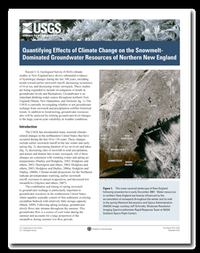Recent U.S. Geological Survey (USGS) climate studies in New England have shown substantial evidence of hydrologic changes during the last 100 years, including trends toward earlier snowmelt runoff, decreasing occurrence of river ice, and decreasing winter snowpack. These studies are being expanded to include investigation of trends in groundwater levels and fluctuations. Groundwater is an important drinking-water source throughout northern New England (Maine, New Hampshire, and Vermont). The USGS is currently investigating whether or not groundwater recharge from snowmelt and precipitation exhibits historical trends. In addition to trend-testing, groundwater resources also will be analyzed by relating groundwater-level changes to the large year-to-year variability in weather conditions.
Introduction
The USGS has documented many seasonal climate-related changes in the northeastern United States that have occurred during the last 30 to 150 years. These changes include earlier snowmelt runoff in the late winter and early spring, decreasing duration of ice on rivers and lakes, decreasing ratio of snowfall to total precipitation, and denser and thinner late-winter snowpack. All of these changes are consistent with warming winter and spring air temperatures (Dudley and Hodgkins, 2002; Hodgkins and others, 2002; Huntington and others, 2004; Hodgkins and others, 2005; Hodgkins and Dudley, 2006a; Hodgkins and Dudley, 2006b). Climate-model projections for the Northeast indicate air-temperature warming, earlier snowmelt runoff, increases in annual evaporation, and decreased low streamflows (Hayhoe and others, 2007).
The contribution and timing of spring snowmelt to groundwater recharge is particularly important to groundwater resources in the northeastern United States where aquifers typically consist of thin sediments overlying crystalline bedrock with relatively little storage capacity (Mack, 2009). Following spring recharge, groundwater slowly flows into streams throughout the summer. This groundwater flow is a source of cool water during the summer and accounts for a large proportion of the streamflow during summer low-flow periods.
Groundwater is an important drinking-water source in northern New England. Approximately 32 percent of public water suppliers draw water from groundwater sources in Vermont, New Hampshire, and Maine, and approximately 40 percent of the population derives its drinking water from private wells (Kenny and others, 2009). It is vital to understand changes that may be occurring to such an important resource for planning industrial and agricultural water uses and protecting drinking water.


